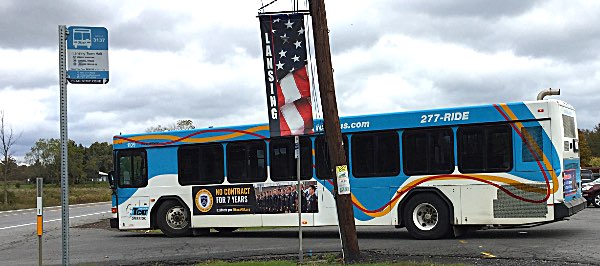- By Patty Poist
- Around Town
 Print
Print 
As the year winds down TCAT's ridership continues to edge upward. And for the first time in five years, TCAT is exceeding previous-year numbers, thanks to Cornell University riders. On Thurs. afternoon, Dec. 6, year-to-date ridership hit the 4 million mark, a numerical threshold TCAT first met in 2012 and was since able to maintain up until last year when ridership numbers came in ever-so-slightly lower at 3,987,830.
TCAT General Manager Scot Vanderpool, in reporting the glad tidings to the TCAT Board of Directors at its monthly meeting Thursday, said: "We still have a few weeks to go before we have 2018 data for the entire year, which should give us even better news,"
Vanderpool added: "In comparison to recent national trends, we are doing great and expect to continue to do so in the coming year."
Unless there are substantial changes in fuel prices, a prolonged spate of bad weather or significant changes to service, it's typically difficult for industry analysts to pin down reasons for the ups and downs in ridership.
"It could be based on population and economic shifts and, of course, cultural changes in how a community views public transit," Vanderpool said. "We like to think that our community is taking more trips on our buses because they realize the many advantages of public transit."
TCAT Analyst Tom Clavel said both Cornell staff and student ridership are up 10 percent, as compared to last year. "This may have to do with changes in student residential patterns, as we see an increase in student ridership on rural routes, as well as on urban and campus routes," Clavel said.
Meantime, Clavel said non-Cornell ridership has been dropping, a trend TCAT is keeping an eye on. In the next year or so, Clavel said, TCAT will be able to dig deeper when it embarks on a Transportation Development Plan (TDP), which occurs every 10 years to revamp and improve the system. The process involves close examination of ridership and population patterns, and intensive public outreach.
TCAT's ridership started declining in 2014 after a seven-year stretch of consecutive growth, which topped out at 4,388,966 passenger trips in 2013. That was a 6.3 percent increase from 2012 when TCAT first cracked the 4- million ceiling with 4,128,242 passenger trips.
Declines in recent years mirrored an overall national shift in ridership. That was until the second half of 2017 when TCAT starting bucking the negative pattern, said Clavel, adding that TCAT also deviated from national trends during its 2007-2013 growth period. See 2017 annual report.
This year, ridership on average for North American systems in TCAT's service population category (100,000-499,999) is down by 1.3 percent, according the American Public Transportation Association's second quarter 2018 transit report, the latest data available.
Crossing the 4-million line does matter to APTA during its annual awards program in which it categorizes agencies by ridership numbers. TCAT is now in APTA's medium-sized category (4-million to 20-million annual passenger trips) as opposed to its former place in the small transit agency category (4 million and under.)
v14i47



